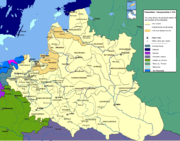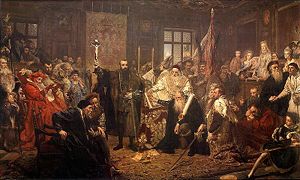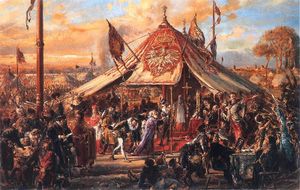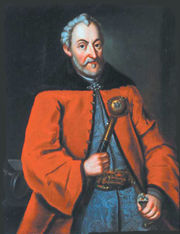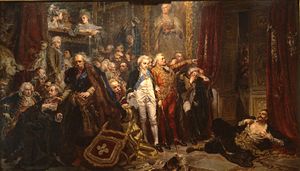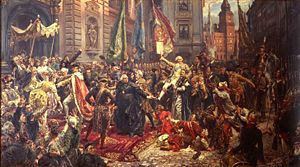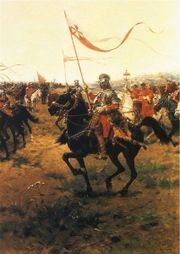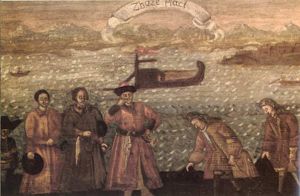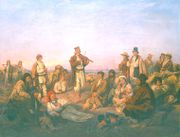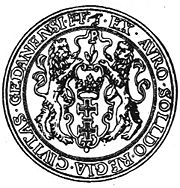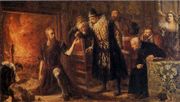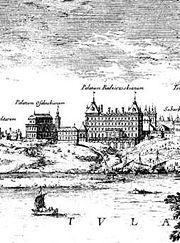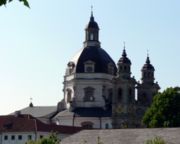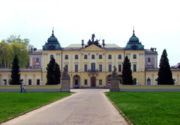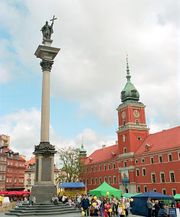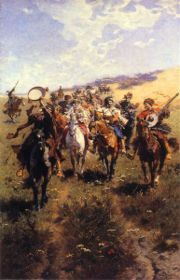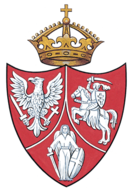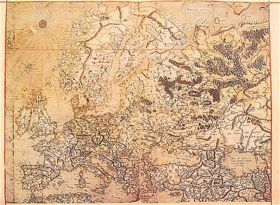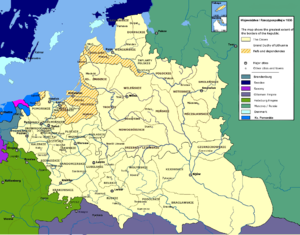Polish–Lithuanian Commonwealth
2008/9 Schools Wikipedia Selection. Related subjects: General history
|
|||||||||||||||||||||||||||||||||||||||||||||||||||||||||||
The Polish–Lithuanian Commonwealth, official Lenkijos Karalystės ir Lietuvos Didžiosios kunigaikštystės respublika, also known as the Most Serene Republic (Commonwealth) of the Two (Both) Nations (Peoples), ( Polish: Pierwsza Rzeczpospolita or Rzeczpospolita Obojga Narodów; Belarusian: Рэч Паспалітая or Рэч Паспалітая Абодвух Народаў; Lithuanian: Abiejų tautų respublika) or as the "First Republic", was one of the largest and most populous countries in 17th-century Europe. Its political structure—that of a semi-federal, semi-confederal aristocratic republic—was formed in 1569 by the Union of Lublin, which united the Crown of the Polish Kingdom and the Grand Duchy of Lithuania, and lasted in this form until the adoption of the Constitution of May 3, 1791. The Commonwealth covered not only the territories of what is now Poland and Lithuania, but also the entire territory of Belarus and Latvia, large parts of Ukraine and Estonia, and part of present-day western Russia ( Smolensk and Kaliningrad oblasts). Originally the official languages of the Commonwealth were Polish and Latin (in the Kingdom of Poland) and Ruthenian and Lithuanian (in the Grand Duchy of Lithuania).
The Commonwealth was an extension of the Polish-Lithuanian Union, a personal union between those two states that had existed from 1386 (see Union of Krewo). The Commonwealth's political system, often called the Noble's democracy or Golden Freedom, was characterized by the sovereign's power being reduced by laws and the legislature ( Sejm) controlled by the nobility ( szlachta). This system was a precursor of the modern concepts of broader democracy and constitutional monarchy as well as federation. The two comprising states of the Commonwealth were formally equal, although in reality Poland was a dominant partner in the union. The Roman Catholic Church had a significant influence on the affairs of the Commonwealth, the state however was noted for having religious tolerance, although the degree of it varied with time. Its economy was mainly based on agriculture. While the Commonwealth's first century was a golden age for both Poland and Lithuania, the second century was marked by military defeats, a return to serfdom for the peasants (the second serfdom phenomenon), and growing anarchy in political life. Shortly before its demise, the Commonwealth adopted the world's second-oldest codified national constitution in modern history.
The Duchy of Warsaw, established in 1807, traced its origins to the Commonwealth. Other revival movements appeared during the January Uprising (1863–64) and in the 1920s, with Józef Piłsudski's failed attempt to create a Polish-led Międzymorze ("Between-Seas") federation that would have included Lithuania and Ukraine. Today's Republic of Poland considers itself a successor to the Commonwealth, whereas the Republic of Lithuania, re-established at the end of World War I, saw the participation of the Lithuanian state in the old Polish–Lithuanian Commonwealth mostly in a negative light, at the early stages of regaining its independence, although the attitude has changed significantly.
History
The creation of the Commonwealth by the Union of Lublin in 1569 was one of the signal achievements of Sigismund II Augustus, last king of the Jagiellon dynasty, in an effort to preserve the monarchy by adopting elective monarchy. His death in 1572 was followed by a three-year interregnum during which adjustments were made to the constitutional system that effectively increased the power of the nobility (the szlachta) and established a truly elective monarchy.
The Commonwealth reached its Golden Age in the first half of the 17th century. Its powerful parliament (the Sejm) was dominated by nobles who were reluctant to get involved in the Thirty Years' War, sparing the country from the ravages of this largely religious conflict devastating most of contemporary Europe. The Commonwealth was able to hold its own against Sweden, Russia, and vassals of the Ottoman Empire, and at times launched successful expansionist offensives against its neighbors. During several invasions of Russia, which was weakened in the early 17th century by the Time of Troubles, Commonwealth troops managed to take Moscow and hold on to it from 27 September 1610 to 4 November 1612, until driven out after a siege.
Commonwealth power waned after a double blow in 1648. The first blow was history's greatest Cossack rebellion (the Khmelnytskyi Uprising, supported by Crimean Khanate Tatars, in the eastern territories of Kresy), which resulted in Cossacks asking for the protection of the Russian Tzar (1654) thus leading to Russian influence over Ukraine gradually supplanting the Polish. The other blow to the Commonwealth was the Swedish invasion in 1655 (supported by troops of Transylvanian duke George II Rakoczy and Friedrich Wilhelm I, Elector of Brandenburg), known as The Deluge, provoked by the policies of Commonwealth kings from the Swedish royal House of Vasa.
In the late 17th century, the weakened Commonwealth under King John III Sobieski in alliance with the forces of the Holy Roman emperor Leopold I dealt crushing defeats to the Ottoman Empire: In 1683, the Battle of Vienna marked the final turning point in a 250-year struggle between the forces of Christian Europe and the Islamic Ottoman Empire. For its centuries-long stance against the Muslim advances, the Commonwealth would gain the name of Antemurale Christianitatis (forefront of Christianity). Over the next 16 years (in the " Great Turkish War"), the Turks would be permanently driven south of the Danube River, never to threaten central Europe again.
By the 18th century, the Commonwealth was facing many internal problems and was vulnerable to foreign influences. Destabilization of its political system brought it to the brink of anarchy. Attempts at reform, such as those made by the Four-Year Sejm of 1788–92, which culminated in the May 3rd Constitution of 1791, came too late, and the country was partitioned in three stages by the neighboring Russian Empire, Kingdom of Prussia, and the Habsburg Monarchy. By 1795, the Polish–Lithuanian Commonwealth had been completely erased from the map of Europe. Poland and Lithuania re-established their independence, as separate countries, only in 1918.
State organization and politics
Golden Liberty
The political doctrine of the Commonwealth of Both Nations was: our state is a republic under the presidency of the King. Chancellor Jan Zamoyski summed up this doctrine when he said that Rex regnat et non gubernat ("The King reigns but does not govern"). The Commonwealth had a parliament, the Sejm, as well as a Senat and an elected king. The king was obliged to respect citizens' rights specified in King Henry's Articles as well as in pacta conventa, negotiated at the time of his election.
The monarch's power was limited, in favour of a sizable noble class. Each new king had to subscribe to King Henry's Articles, which were the basis of Poland's political system (and included near-unprecedented guarantees of religious tolerance). Over time, King Henry's Articles were merged with the pacta conventa, specific pledges agreed to by the king-elect. From that point onwards, the king was effectively a partner with the noble class and was constantly supervised by a group of senators.
The foundation of the Commonwealth's political system, the " Golden Liberty" ( Polish: Zlota Wolność, a term used from 1573 on), included:
- free election of the king by all nobles wishing to participate;
- Sejm, the Commonwealth parliament which the king was required to hold every two years;
- pacta conventa (Latin), "agreed-to agreements" negotiated with the king-elect, including a bill of rights, binding on the king, derived from the earlier King Henry's Articles.
- rokosz ( insurrection), the right of szlachta to form a legal rebellion against a king who violated their guaranteed freedoms;
- liberum veto (Latin), the right of an individual Sejm deputy to oppose a decision by the majority in a Sejm session; the voicing of such a "free veto" nullified all the legislation that had been passed at that session; during the crisis of the second half of the 17th century, Polish nobles could also use the liberum veto in provincial sejmiks;
- konfederacja (from the Latin confederatio), the right to form an organization to force through a common political aim.
The three regions (see below) of the Commonwealth enjoyed a degree of autonomy. Each voivodship had its own parliament (sejmik), which exercised serious political power, including choice of poseł ( deputy) to the national Sejm and charging of the deputy with specific voting instructions. The Grand Duchy of Lithuania had its own separate army, treasury and most other official institutions.
Golden Liberty created a state that was unusual for its time, although somewhat similar political systems existed in the contemporary city-states like the Republic of Venice. (Interestingly, both states were styled the " Most Serene Republic".) At a time when most European countries were headed toward centralization, absolute monarchy and religious and dynastic warfare, the Commonwealth experimented with decentralization, confederation and federation, democracy, religious tolerance, and even pacifism. Since the Sejm usually vetoed a monarch's plans for war, this constitutes a notable argument for the democratic peace theory.
This political system unusual for its time stemmed from the victories of the szlachta noble class over other social classes and over the political system of monarchy. In time, the szlachta accumulated enough privileges (such as those established by the Nihil novi Act of 1505) that no monarch could hope to break the szlachta's grip on power. The Commonwealth's political system is difficult to fit into a simple category, but it can be tentatively described as a mixture of:
- confederation and federation, with regard to the broad autonomy of its regions. It is, however, difficult to decisively call the Commonwealth either confederation or federation, as it had some qualities of both of them;
- oligarchy, as only the szlachta—around 10% of the population—had political rights;
- democracy, since all the szlachta were equal in rights and privileges, and the Sejm could veto the king on important matters, including legislation (the adoption of new laws), foreign affairs, declaration of war, and taxation (changes of existing taxes or the levying of new ones). Also, the 10% of Commonwealth population who enjoyed those political rights (the szlachta) was a substantially larger percentage than in any other European country (needs citation); note that in 1831 in France only about 1% of the population had the right to vote, and in 1867 in the United Kingdom, only about 3% (needs citation);
- elective monarchy, since the monarch, elected by the szlachta, was Head of State;
- constitutional monarchy, since the monarch was bound by pacta conventa and other laws, and the szlachta could disobey any king's decrees they deemed illegal.
The political players
The major players in the politics of the Commonwealth were:
- monarchs, who struggled to expand their power and create an absolute monarchy.
- magnates, the wealthiest of the szlachta, who wanted to rule the country as a privileged oligarchy, and to dominate both the monarch and the poorer nobles.
- szlachta, who desired a strengthening of the Sejm and rule of the country as a democracy of the szlachta.
The magnates and the szlachta were far from united, with many factions supporting either the monarch or various of the magnates.
Shortcomings of the Commonwealth
Once the Jagiellons had disappeared from the scene in 1572, the fragile equilibrium of the Commonwealth's government was disrupted. Power increasingly slipped away from the central government to the nobility.
When presented with periodic opportunities to fill the throne, the szlachta exhibited a preference for foreign candidates who would not found another strong dynasty. This policy often produced monarchs who were either totally ineffective or in constant debilitating conflict with the nobility. Furthermore, aside from notable exceptions such as the able Transylvanian Stefan Batory (1576–86), the kings of foreign origin were inclined to subordinate the interests of the Commonwealth to those of their own country and ruling house. This was especially visible in the policies and actions of the first two elected kings from the Swedish House of Vasa, whose politics brought the Commonwealth into conflict with Sweden, culminating in the war known as The Deluge (1648), one of the events that mark the end of the Commonwealth's Golden Age and the beginning of the Commonwealth's decline.
Zebrzydowski's rokosz (1606–07) marked a substantial increase in the power of the magnates, and the transformation of szlachta democracy into magnate oligarchy. The Commonwealth's political system was vulnerable to outside interference, as Sejm deputies bribed by foreign powers might use their liberum veto to block attempted reforms. This sapped the Commonwealth and plunged it into political paralysis and anarchy for over a century, from the mid-17th century to the end of the 18th, while its neighbors stabilized their internal affairs and increased their military might.
Late reforms
The Commonwealth did eventually make a serious effort to reform its political system, adopting in 1791 the May 3rd Constitution, Europe's first codified national constitution in Modern Times, and the world's second, after the United States Constitution, which had been ratified two years earlier. The revolutionary Constitution recast the erstwhile Polish–Lithuanian Commonwealth as a Polish–Lithuanian federal state with a hereditary monarchy and abolished many of the deleterious features of the old system. The new constitution:
- abolished the liberum veto and banned the szlachta's confederations;
- provided for a separation of powers among legislative, executive and judicial branches of government;
- established " popular sovereignty" and extended political rights to include not only the nobility but the bourgeoisie;
- increased the rights of the peasantry;
- preserved religious tolerance (but with a condemnation of apostasy from the Catholic faith).
These reforms came too late, however, as the Commonwealth was immediately invaded from all sides by its neighbors which were content to leave the Commonwealth alone as a weak buffer state, but reacted strongly to king Stanisław August Poniatowski's and other reformers' attempts to strengthen the country. Russia feared the revolutionary implications of the May 3rd Constitution's political reforms and the prospect of the Commonwealth regaining its position as a European empire. Catherine the Great regarded the May constitution as fatal to her influence and declared the Polish constitution Jacobinical. Grigori Aleksandrovich Potemkin drafted the act for the Confederation of Targowica, referring to the constitution as the "contagion of democratic ideas". Meanwhile, Prussia and Austria, also afraid of a strengthened Poland, used it as a pretext for further territorial expansion. Prussian minister Ewald von Hertzberg called the constitution "a blow to the Prussian monarchy", fearing that strengthened Poland would once again dominate Prussia. In the end, the May 3rd Constitution was never fully implemented, and the Commonwealth entirely ceased to exist only four years after the Constitution's adoption.
Commonwealth military
Commonwealth armies were commanded by two Grand Hetmans and two Field Hetmans. The armies comprised:
- Wojsko kwarciane: Regular units with wages paid from taxes (these units were later merged with the wojsko komputowe)
- Wojsko komputowe: Semi-regular units created for times of war (in 1652 these units were merged with the wojsko kwarciane into a new permanent army)
- Pospolite ruszenie: Szlachta levée en masse
- Piechota łanowa and piechota wybraniecka: Units based on peasant recruits
- Registered Cossacks: Troops made up of Cossacks, used mainly as infantry, less often as cavalry (with tabors) were recruited.
- Royal guard: A small unit whose primary purpose was to escort the monarch and members of his family
- Mercenaries: As with most other armies, hired to supplement regular units, such as Germans, Scots, Wallachians, Serbs, Hungarians, Bohemians, Moravians and Silesians.
- Private armies: In time of peace usually small regiments (few hundred men) were paid for and equipped by magnates or cities. However, in times of war, they were greatly augmented (to even a few thousand men) and paid by state
Some units of the Commonwealth included:
- Hussars: heavy cavalry armed with lances; their charges were extremely effective until advances in firearms in the late 17th century substantially increased infantry firepower. Members were known as towarzysz husarski and were supported by pocztowy's.
- Pancerni: medium cavalry, armed with sabers or axes, bows, later pistols. Second important cavalry branch of the Polish army.
- Pocztowi: assistants of pancerni.
- Cossack cavalry general name for all Commonwealth units of light cavalry, even if they did not contain a single ethnic Cossack; fast and maneuverable like oriental cavalry units of Ottoman Empire vassals, but lacking the firepower of European cavalry such as the Swedish pistol-armed reiters.
- Tabor: military horse-drawn wagons, usually carrying army supplies. Their use for defensive formations was perfected by the Cossacks, and to a smaller extent by other Commonwealth units.
The Commonwealth Navy was small and played a relatively minor role in the history of the Commonwealth, but won the very important naval battle of Oliwa, breaking Swedish sea blockade in 1627. On the Black Sea, Cossacks with their small boats (czajka) were known for their plundering raids against the Ottoman Empire and its vassals (they even burned suburbs of Istanbul once or twice).
Economy
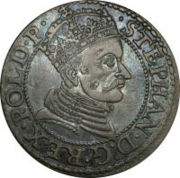
The economy of the Commonwealth was dominated by feudal agriculture based on exploitation of agricultural workforce ( serfs). Slavery in Poland was forbidden in the 15th century; in Lithuania, slavery was formally abolished in 1588. they were replaced by the second enserfment. Typically a nobleman's landholding comprised a folwark, a large farm worked by serfs to produce surpluses for internal and external trade. This economic arrangement worked well for the ruling classes in the early era of the Commonwealth, which was one of the most prosperous eras of the grain trade . However the country's situation worsened from the late 17th century on, when the landed szlachta sought to compensate for falling grain prices by increasing the peasants' workload, thus leading to the creation of second serfdom, a phenomenon common throughout contemporary Eastern Europe.
The Commonwealth's preoccupation with agriculture, coupled with the szlachta's dominance over the bourgeoisie, resulted in a fairly slow process of urbanization and thus a fairly slow development of industries. While similar conflicts among social classes may be found all over Europe, nowhere were the nobility as dominant at the time as in the Polish-Lithuanian Commonwealth. There is, however, much debate among historians as to which processes most affected those developments, since until the wars and crises of the mid-17th century the cities of the Commonwealth had not markedly lagged in size and wealth behind their western counterparts. The Commonwealth did have numerous towns and cities, commonly founded on Magdeburg rights. Some of the largest trade fairs in the Commonwealth were held at Lublin. See the geography section, below, for a list of major cities in the Commonwealth (commonly capitals of voivodships).
Although the Commonwealth was Europe's largest grain producer, the bulk of her grain was consumed domestically. Estimated grain consumption in the Polish Crown (Poland proper) and Prussia in 1560–70 was some 113,000 tons of wheat (or 226,000 łaszt (a łaszt, or " last", being a large bulk measure; in the case of grain, about half a ton). Average yearly production of grain in the Commonwealth in the 16th century was 120,000 tons, 6% of which was exported, while cities consumed some 19% and the remainder was consumed by the villages. The exports probably satisfied about 2% of the demand for grain in Western Europe, feeding 750,000 people there. Commonwealth grain achieved far more importance in poor crop years, as in the early 1590s and the 1620s, when governments throughout southern Europe arranged for large grain imports to cover shortfalls in their jurisdictions.
Still, grain was the largest export commodity of the Commonwealth. The owner of a folwark usually signed a contract with merchants of Gdansk (German Danzig), who controlled 80% of this inland trade, to ship the grain north to that seaport on the Baltic Sea. Many rivers in the Commonwealth were used for shipping purposes: the Vistula, Pilica, Western Bug, San, Nida, Wieprz, Niemen. The rivers had relatively developed infrastructure, with river ports and granaries. Most of the river shipping moved north, southward transport being less profitable, and barges and rafts were often sold off in Gdańsk for lumber.
From Gdańsk, ships, mostly from the Netherlands and Flanders, carried the grain to ports such as Antwerp and Amsterdam. Gdańsk ships accounted for only 2–10% of this maritime trade. Besides grain, other seaborne exports included lumber and wood-related products such as tar and ash.
By land routes, the Commonwealth exported hides, furs, hemp, cotton (mostly from Wielkopolska) and linen to the German lands of the Holy Roman Empire, including cities like Leipzig and Nuremberg. Large herds (of around 50,000 head) of cattle were driven south through Silesia.
The Commonwealth imported spices, luxury goods, clothing, fish, beer and industrial products like steel and tools. A few riverboats carried south imports from Gdańsk like wine, fruit, spices and herring. Somewhere between the 16th and 17th centuries, the Commonwealth's trade balance shifted from positive to negative.
With the advent of the Age of Exploration, many old trading routes such as the Amber Road lost importance as new ones were created. Poland's importance as a caravan route between Asia and Europe diminished, while new local trading routes were created between the Commonwealth and Russia. But even with improvements in shipping technology the Commonwealth remained an important link between Occident and Orient, as many goods and cultural artifacts passed from one region to another via the Commonwealth. For example, Isfahan rugs imported from Persia to the Commonwealth were actually known in the West as "Polish rugs". Also, the price of eastern spices in Poland was several times lower than in western ports, which led to the creation of a distinct Polish cuisine, owing much both to the eastern and western influence.
Commonwealth currency included the złoty and the grosz. The City of Gdańsk had the privilege of minting its own coinage.
Culture
The Commonwealth was an important European centre for the development of modern social and political ideas. It was famous for its rare quasi-democratic political system, praised by philosophers such as Erasmus; and, during the Counter-Reformation, was known for near-unparalleled religious tolerance, with peacefully coexisting Catholic, Jewish, Eastern Orthodox, Protestant and Muslim communities. The Commonwealth gave rise to the famous Christian sect of the Polish Brethren, antecedents of British and American Unitarianism.
With its political system, the Commonwealth gave birth to political philosophers such as Andrzej Frycz Modrzewski (1503–72), Wawrzyniec Grzymała Goślicki (1530–1607) and Piotr Skarga (1536–1612). Later, works by Stanisław Staszic (1755–1826) and Hugo Kołłątaj (1750–1812) helped pave the way for the Constitution of May 3, 1791, the first modern codified national constitution in Europe, which enacted revolutionary political principles for the first time on that continent.
Kraków's Jagiellonian University is one of the oldest universities in the world. Vilnius University and the Jagiellonian University were the major scholarly and scientific centers in the Commonwealth. The Komisja Edukacji Narodowej, (Polish for Commission for National Education), formed in 1773, was the world's first national Ministry of Education. Commonwealth scientists included:
- Martin Kromer (1512–89), historian and cartographer,
- Michał Sędziwój (1566–1636), alchemist and chemist,
- Kazimierz Siemienowicz (1600–51), military engineer, artillery specialist and a founder of rocketry,
- Johannes Hevelius (1611–87), astronomer, founder of lunar topography.
The many classics of Commonwealth literature include:
- Jan Kochanowski, (1530–84), writer, dramatist and poet;
- Wacław Potocki, (1621–96), writer, poet;
- Ignacy Krasicki, (1735–1801), writer, poet, fabulist, author of the first Polish novel;
- Julian Ursyn Niemcewicz, (1758–1841), writer, dramatist and poet.
Many szlachta members wrote memoirs and diaries. Perhaps the most famous are the Memoirs of Polish History by Albrycht Stanisław Radziwiłł (1595–1656) and the Memoirs of Jan Chryzostom Pasek (ca. 1636 – ca. 1701).
Magnates often undertook construction projects as monuments to themselves: churches, cathedrals, and palaces like the present-day Presidential Palace in Warsaw built by Grand Hetman Stanisław Koniecpolski herbu Pobóg. The largest projects involved entire towns, although in time many of them would lapse into obscurity or be totally abandoned. Usually they were named after the sponsoring magnate. Among the most famous is the town of Zamość, founded by Jan Zamoyski and designed by the Italian architect Bernardo Morando.
Szlachta and Sarmatism
The prevalent ideology of the szlachta became " Sarmatism", named after the Sarmatians, alleged ancestors of the Poles. This belief system was an important part of the szlachta's culture, penetrating all aspects of its life. Sarmatism enshrined equality among szlachta, horseback riding, tradition, provincial rural life, peace and pacifism; championed oriental-inspired attire ( żupan, kontusz, sukmana, pas kontuszowy, delia, szabla); and served to integrate the multi-ethnic nobility by creating an almost nationalistic sense of unity and of pride in the szlachta's Golden Freedoms.
In its early, idealistic form, Sarmatism represented a positive cultural movement: it supported religious belief, honesty, national pride, courage, equality and freedom. In time, however, it became distorted. Late extreme Sarmatism turned belief into bigotry, honesty into political naïveté, pride into arrogance, courage into stubbornness and freedom into anarchy.
Demographics and religion
The population of the Commonwealth of Both Nations was never overwhelmingly either Roman Catholic or Polish. This circumstance resulted from Poland's possession of Ukraine and confederation with Lithuania, in both of which countries ethnic Poles were a distinct minority. The Commonwealth comprised primarily four nations: Lithuanians, Poles, Belarusians and Ukrainians; the latter two usually referred to as the Ruthenians. Sometimes inhabitants of the Grand Duchy of Lithuania were called Litvins, a Slavic term for Lithuanians, despite being of different ethnicities. Shortly after the Union of Lublin, the Commonwealth population was around 7 million, with a rough breakdown of 4.5 m Poles, 0.75 m Lithuanians, 0.7 m Jews and 2 m Ruthenians. In 1618, after the Truce of Deulino, the Commonwealth population increased together with its territory, reaching 11.5 million people, which was composed roughly of 4.5 m Poles, 3.5 m Ukrainians, 1.5 m Belarusians, 0.75 m Lithuanians, 0.75 m Prussians, 0.5 m Jews, and 0.5 m Livonians. At that time nobility was 10% of the population, and burghers were 15%. In the period from 1648–57, populations losses are estimated at 4 m. Coupled with further population and territorial losses, in 1717 the Commonwealth population had fallen to 9 m, with roughly 4.5 m Poles, 1.5 m Ukrainians, 1.2 m Belarusians, 0.8 m Lithuanians, 0.5 m Jews, and 0.5 m others.
To be Polish, in the non-Polish lands of the Commonwealth, was then much less an index of ethnicity than of religion and rank; it was a designation largely reserved for the landed noble class (szlachta), which included Poles but also many members of non-Polish origin who converted to Catholicism in increasing numbers with each following generation. For the non-Polish noble such conversion meant a final step of Polonization that followed the adoption of the Polish language and culture. Poland, as the culturally most advanced part of the Commonwealth, with the royal court, the capital, the largest cities, the second-oldest university in Central Europe (after Prague), and the more liberal and democratic social institutions had proven an irresistible magnet for the non-Polish nobility in the Commonwealth.
As a result, in the eastern territories a Polish (or Polonized) aristocracy dominated a peasantry whose great majority was neither Polish nor Roman Catholic. Moreover, the decades of peace brought huge colonization efforts to Ukraine, heightening the tensions among nobles, Jews, Cossacks (traditionally Orthodox), Polish and Ruthenian peasants. The latter, deprived of their native protectors among the Ruthenian nobility, turned for protection to cossacks that facilitated violence that in the end broke the Commonwealth. The tensions were aggravated by conflicts between Eastern Orthodoxy and the Greek Catholic Church following the Union of Brest, overall discrimination of Orthodox religions by dominant Catholicism, and several Cossack uprisings. In the west and north, many cities had sizable German minorities, often belonging to Reformed churches. The Commonwealth had also one of the largest Jewish diasporas in the world.
Until the Reformation, the szlachta were mostly Catholic or Eastern Orthodox. However, many families quickly adopted the Reformed religion. After the Counter-Reformation, when the Roman Catholic Church regained power in Poland, the szlachta became almost exclusively Roman Catholic, despite the fact that Roman Catholicism was not a majority religion (the Roman Catholic and Orthodox churches counted approximately 40% of the population each, while the remaining 20% were Jews and members of various Protestant churches). It should be noted that the Counter-Reformation in Poland, influenced by the Commonwealth tradition of religious tolerance, was based mostly on Jesuit propaganda and was very peaceful when compared to excesses such as the Thirty Years' War elsewhere in Europe.
Languages of the Commonwealth
- Polish (officially recognized; dominant language, used by most of Commonwealth nobility and by peasantry in the Crown province; official language in Crown chancellery and since 1697 in Grand Duchy chancellery) Dominant language in the towns.
- Latin (off. recog.; commonly used in foreign relations and popular as second language among the nobility)
- Lithuanian (not off. recog. but used in some official documents in Grand Duchy and by some peasantry in Grand Duchy)
- German (off. recog.; used in some foreign relations, in Royal Prussia and by minorities in cities)
- Hebrew (off. recog.; used by the Jews; Yiddish was also used but not recognized as official language)
- Ruthenian (also known as Chancery Slavonic; off. recog.; official language in Grand Duchy chancellery until 1697; used in some foreign relations and some peasants in Ruthenian province)
- Armenian (off. recog. used by Armenian minority)
Provinces and geography
The lands that once belonged to the Commonwealth are now largely distributed among several Central and East European countries:
Poland, Ukraine, Moldova ( Transnistria), Belarus, Russia, Lithuania, Latvia, and Estonia. Also some small towns in Slovakia, then within the Kingdom of Hungary, became a part of Poland in the Treaty of Lubowla.
While the term "Poland" was also commonly used to denote this whole polity, Poland was in fact only part of a greater whole—the Polish–Lithuanian Commonwealth, which comprised primarily two parts:
- the Crown of the Polish Kingdom (Poland proper), colloquially "the Crown"; and
- the Grand Duchy of Lithuania, colloquially "Lithuania".
The Crown in turn comprised two great regions (" prowincjas"): Wielkopolska or Greater Poland and Małopolska or Lesser Poland, and another titular nation of the Commonwealth was the Grand Duchy of Lithuania. The Commonwealth was further divided into smaller administrative units known as voivodships (województwa). Each voivodship was governed by a voivod (wojewoda, governor). Voivodships were further divided into starostwa, each starostwo being governed by a starosta. Cities were governed by castellans. There were frequent exceptions to these rules, often involving the ziemia subunit of administration: for details on the administrative structure of the Commonwealth, see the article on offices in the Polish-Lithuanian Commonwealth.
Other notable parts of the Commonwealth often referred to, without respect to region or voivodship divisions, include:
- Lesser Poland (Małopolska), southern Poland, with its capital at Kraków (Cracow);
- Greater Poland (Wielkopolska), west–central Poland around Poznań and the Warta River system;
- Masovia (Mazowsze), central Poland, with its capital at Warszawa (Warsaw);
- Samogitia (Żmudź), western Lithuania;
- Royal Prussia (Prusy Królewskie), at the southern shore of the Baltic Sea, was an autonomous area since the Second Peace of Thorn (1466), incorporated into the Crown in 1569 with the Commonwealth's formation;
- Pomerelia (Pomorze Gdańskie), Pomerania around Gdańsk (Danzig), western part of Royal Prussia;
- Ruthenia (Ruś), the eastern Commonwealth, adjoining Russia;
- Duchy of Livonia (Inflanty), a joint domain of the Crown and the Grand Duchy of Lithuania. Parts lost to Sweden in the 1620s and in 1660;
- Duchy of Courland (Kurlandia), a northern fief of the Commonwealth. It established a colony in Tobago in 1637 and on St. Andrews Island at the Gambia River in 1651 (see Courland colonization);
- Silesia (Śląsk) was not within the Commonwealth, but small parts belonged to various Commonwealth kings; in particular, the Vasa kings were dukes of Opole from 1645 to 1666.
Commonwealth borders shifted with wars and treaties, sometimes several times in a decade, especially in the eastern and southern parts.
Thought was given at various times to the creation of a Duchy of Ruthenia, particularly during the 1648 Cossack insurrection against Polish rule in Ukraine. Such a Duchy, as proposed in the 1658 Treaty of Hadiach, would have been a full member of the Commonwealth, which would thereupon have become a tripartite Polish–Lithuanian–Ruthenian Commonwealth or Commonwealth of Three Nations, but due to szlachta demands, Muscovite invasion, and division among the Cossacks, the plan was never implemented. For similar reasons, plans for a Polish-Lithuanian-Muscovite Commonwealth also were never realized, although during the Polish–Muscovite War (1605–18) the Polish Prince (later, King) Władysław IV Waza was briefly elected Tsar of Muscovy.
The Crown had about double the population of Lithuania and five times the income of the latter's treasury. As with other countries, the borders, area and population of the Commonwealth varied over time. After the Peace of Jam Zapolski (1582), the Commonwealth had approximately 815,000 km² area and a population of 6.5 million. After the Truce of Deulino (1618), the Commonwealth had an area of some 990,000 km² and a population of 10–11 million (including some 4 million Poles). In the 16th century, the Polish bishop and cartographer Martin Kromer published a Latin atlas, entitled Poland: about Its Location, People, Culture, Offices and the Polish Commonwealth, which was regarded as the most comprehensive guide to the country.
Kromer's works and other contemporary maps, such as those of Gerardus Mercator, show the Commonwealth as mostly plains. The Commonwealth's southeastern part, the Kresy, was famous for its steppes. The Carpathian Mountains formed part of the southern border, with the Tatra Mountain chain the highest, and the Baltic Sea formed the Commonwealth's northern border. As with most European countries at the time, the Commonwealth had extensive forest cover, especially in the east. Today, what remains of the Białowieża Forest constitutes the last largely intact primeval forest in Europe.
Voivodeships of the Commonwealth
Note that some sources use the word palatinate instead of voivodship.
Greater Poland
- Brześć Kujawski Voivodeship (województwo brzesko-kujawskie, Brześć Kujawski)
- Gniezno Voivodeship (województwo gnieźnieńskie, Gniezno) from 1768
- Inowrocław Voivodeship (województwo inowrocławskie, Inowrocław)
- Kalisz Voivodeship (województwo kaliskie, Kalisz)
- Łęczyca Voivodeship (województwo łęczyckie, Łęczyca)
- Mazovian Voivodeship (województwo mazowieckie, of Mazowsze, Warsaw) consisting of
- County of Ciechanów (ziemia ciechanowska, Ciechanów)
- County of Czersk (ziemia czerska, Czersk)
- County of Liw (ziemia liwska, Liw)
- County of Łomża (ziemia łomżyńska, Łomża)
- County of Nur (ziemia nurska, Nur)
- County of Różan (ziemia różańska, Różan)
- County of Warszawa (ziemia warszawska, Warsaw)
- County of Wisk (ziemia wiska, Wizna)
- Poznań Voivodeship (województwo poznańskie, Poznań)
- Płock Voivodeship (województwo płockie, Płock) consisting of
- County of Wyszogród (ziemia wyszogrodzka, Wyszogród)
- County of Zawkrzeń (ziemia zawkrzeńska, Zawkrzeń)
- Podlasie Voivodeship (województwo podlaskie, Drohiczyn) consisting of:
- County of Bielsk (ziemia bielska, Bielsk)
- Country of Drohiczyn (ziemia drohicka, Drohiczyn)
- Country of Mielnik (ziemia mielnicka, Mielnik)
- Rawa Voivodeship (województwo rawskie, Rawa) consisting of
- County of Rawa (ziemia rawska, Rawa)
- County of Gostyń (ziemia gostyńska, Gostyń)
- County of Sochaczew (ziema sochaczewska, Sochaczew)
- Sieradz Voivodeship (województwo sieradzkie, Sieradz)
- County of Dobrzyń (ziemia dobrzyńska, Dobrzyń)
- County of Michałów (ziemia michałkowicka, Michałów)
- County of Wieluń (ziemia wieluńska, Wieluń)
- County of Wschów (ziema wschowska, Wschów)
Lesser Poland
- Bełz Voivodeship (województwo bełzkie, Bełz)
- Bracław Voivodeship (województwo bracławskie, Bracław)
- Czernichów Voivodeship (województwo czernichowskie, Czernichów)
- Kijów Voivodeship (województwo kijowskie, Kijów)
- Kraków Voivodeship (województwo krakowskie, Kraków)
- Lublin Voivodeship (województwo lubelskie, Lublin)
- Podole Voivodeship (województwo podolskie, Kamieniec Podolski)
- Ruś Voivodeship (województwo ruskie, Lwów), divided into
- Sandomierz Voivodeship (województwo sandomierskie, Sandomierz)
- Wołyń Voivodeship (województwo wołyńskie, Łuck)
- County of Halicz (ziemia halicka, Halicz)
- County of Lwów (ziemia lwowska, Lwów)
- Country of Przemyśl (ziemia przemyslka, Przemyśl)
- County of Sanock (ziemia sanocka, Sanok)
- Duchy of Siewierz (księstwo Siewierskie, Siewierz)
- County of Chełm (ziemia chełmska, Chełm)
- Duchy of Oświęcim and Zator ( Oświęcim, Zator)
Grand Duchy of Lithuania
- Eldership of Samogitia (principality of Samogitia, księstwo żmudzkie, Varniai-Medininkai)
- Brześć Litewski Voivodeship (województwo brzesko-litewskie, Brest)
- Mścisław Voivodeship (województwo mścisławskie, Mstsislau)
- Mińsk Voivodeship (województwo mińskie, Minsk)
- Nowogródek Voivodeship (województwo nowogrodzkie, Navahrudak)
- Połock Voivodeship (województwo połockie, Polatsk)
- Smoleńsk Voivodeship (województwo smoleńskie, Smoleńsk)
- Trakai Voivodeship (województwo trockie, Trakai)
- Vilnius Voivodeship (województwo wileńskie, Vilnius)
- Witebsk Voivodeship (województwo witebskie, Vitsebsk)
Royal Prussia
- Duchy of Warmia (Księstwo Warmińskie, episcopal principality of Warmia, Lidzbark Warmiński)
- Chełmno Voivodeship (województwo chełmińskie, Chełmno)
- Malbork Voivodeship (województwo malborskie, Malbork)
- Pomeranian Voivodeship (województwo pomorskie, Gdańsk)
Duchy of Livonia (Inflanty)
- Dorpat Voivodeship (województwo dorpackie, Dorpat) from 1598 to 1620s
- Livonian Voivodeship (województwo inflanckie, Dyneburg) from 1620s
- Parnawa Voivodeship (województwo parnawskie, Parnawa) from 1598 to 1620s
- Wenden Voivodeship (województwo wendeńskie, Wenden) from 1598 to 1620s




